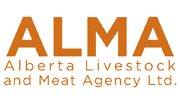Measuring the Canadian Beef Advantage
| Project Code: | BQU.01.11 |
| Completed: | April 2016 |
Project Title:
Researchers:
Dr. Jennifer Aalhus aalhusj@agr.gc.ca
Cindy Delaloye (Canadian Beef Grading Agency), Mike Dugan Ph.D., Manuel Juarez Ph.D., Oscar López-Campos Ph.D., Argenis Rodas-González Ph.D. and Bethany Uttaro Ph.D. (Agriculture and Agri-Food Canada (AAFC) Lacombe), Nuria Prieto Ph.D., (Instituto de Ganadería de Montaña, Spain) and Candido Pomar Ph.D. (AAFC Lennoxville)
Background
The Canadian Beef Grading Agency calculates lean meat yield from backfat depth and ribeye area using an equation developed by Agriculture and Agri-Food Canada (AAFC) researchers in Lacombe, Alberta. Having an impartial third party like AAFC develop yield grade prediction equations helps ensure that neither the packer nor the cattle feeder has an unfair advantage in assessing the value of an individual carcass.
The precise relationship between fat depth and muscle area can change over time as breeds, genetics, and feeding practices change. This means that the yield grade prediction equation needs to be re-calibrated periodically. This is very expensive in terms of labour as well as lost product value. It requires measuring weight, backfat depth and ribeye area on several hundred carcasses, then completely dissecting the carcasses into fat, lean and bone that have significantly less value than the retail cuts they could have been sold as otherwise. Statistical techniques called regression are used to determine the relative weightings and combinations of backfat and ribeye area measurements that give the best prediction of carcass composition. Due to the tremendous expense, these recalibrations are not done very often. Full carcass dissections are rare in research projects for the same reason. Exploiting imaging technologies that could avoid the need for full carcass dissections would help the Canadian beef industry refine its yield grade equations more often, at a lower cost.
${pageBreak}
Objectives
To develop a platform technology for rapid and accurate prediction of total carcass lean yield or yield of closely trimmed, boneless retail cuts which could then be used in either ongoing grading/classification research or adapted to commercial situations to increase the Canadian yield advantage and increase the efficiency of beef production.
What they did
A total of 316 animals were used to develop and validate the prediction models. All the cuts were scanned using Dual X-ray Absorptiometry (DEXA) technology and then fully dissected into fat (subcutaneous (SQ), intermuscular (IM) and body cavity (BC)), lean and bone and weighed. The DEXA machine isn’t large enough to accommodate whole carcass sides, so each side was cut into primals (chuck, rib, brisket, flank, foreshank, loin, round, and plate).
Single and stepwise regression model procedures were used to evaluate the relationship of DEXA lean, fat and bone values from primal cut scans to cut-out values from manual dissection.
What they learned
The DEXA scans explained well over 90% of carcass lean content, well over 90% of carcass fat content, and around 90% of carcass bone content. It’s not surprising that the correlations weren’t 100%. For example, DEXA would assign marbling to the “fat” column, while marbling would be included in the “lean” category when the carcass was dissected, so DEXA scan correlations of 98% are pretty respectable. It’s also important to note that if two sides of the same carcass were completely dissected, those two results wouldn’t agree 100% either.
The Canadian grading ruler presently used to estimate yield grade explained 56% of carcass lean content, while the USDA meat yield equation explained 34% of the saleable yield of the boneless, closely trimmed round, loin, rib and chuck retail cuts. There was a moderate (R2 = 0.63) relationship between the values estimated by the current Canadian yield and USDA yield equations, suggesting that the two systems probably identify low lean yield and high lean yield carcasses equally well, but may classify intermediate lean yield carcasses differently.
What it means
DEXA technology is a rapid, cost-effective, non-destructive alternative to full carcass dissections. Using DEXA, two people can cut a side into primals and scan them in 35 minutes (1.2 person-hours). After the DEXA scan is completed, the primals can still be fabricated into retail cuts. A traditional full dissection of one beef carcass side usually takes five people two hours (10 person-hours). The full carcass dissection also produces a lot of very lean meat that is great for grinding, but is worth a lot less than the retail cuts it could otherwise have been fabricated into. The DEXA technology will allow AAFC Lacombe to accurately evaluate carcass composition on more research cattle, more quickly and more economically. This will make routine research projects more informative and economical, and allow more regular evaluations and updates of the yield grade equations used in commercial packing plants.









